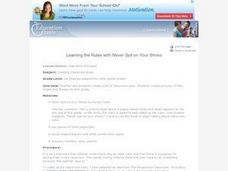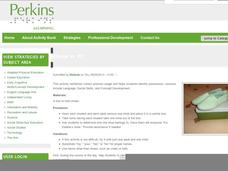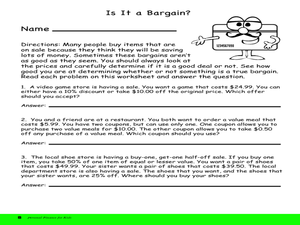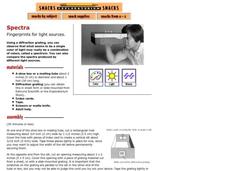Curated OER
Learning the Rules with "Never Spit on Your Shoes"
Foster a sense of community by having youngsters work together to create a list of classroom rules. They draw pictures of their hopes for first grade after reading a children's book as a group. They also discuss why it is important to...
101 Questions
Bone Collector
Feel like a detective yet? Pupils first watch a brief clip from the movie The Bone Collector. Using a photo of the suspect's footprint next to a dollar bill, they then use proportions to determine the size of the suspect's shoe.
Curated OER
Count the Shoes - And Count by 2's
Young mathematicians practice counting by twos in this mathematics presentation. They are shown pictures above red boxes. First they say a number, and then a number is revealed inside the box. Great for young elementary learners who are...
Curated OER
Melba Pattillo and Ruby Bridges: Two Heroes of School Integration
Learners put themselves in the shoes of students who integrated Little Rock High School in 1957-58. Note: The primary resources in this activity provide powerful and poignant descriptions of what those students faced.
Curated OER
Shaquille O'Neal Hand & Foot Span
If Shaquille O'Neal wears a size-20 shoe, how big are his hands? Learners will use the average ratios of foot length to hand span to calculate the hand span of Shaq, but first, they have to collect the data! They will...
Curated OER
Walking in Other People's Shoes
Students study the story of student journalist Casey Parks' September, 2006, journey to Central Africa with New York Times columnist, Nicholas Kristof. They then act as representatives to the tourism boards of developing countries and...
Curated OER
Five Different Uses for . . .
In this higher level thinking learning exercise, students list five different uses for a coin, candy, pine cone, tennis shoe, precious jewels, and pair of socks. Students write 30 answers.
Curated OER
Sole People
Students create "sole people" using tempera paint, drawing paper, and shoe prints in this multi-level art lesson. The lesson can be combined with a brief history of the African-American inventor Jan Ernst Matzeliger, who created the...
Curated OER
No Foot, No Horse
Why do horses wear shoes? Why do people wear shoes? Using worksheets, which are embedded in the plan, learners write descriptive paragraphs about their own shoes, classify a pile of shoes, and also engage in math games about the variety...
Curated OER
Someones Else's Shoes
Build a caring and empathetic classroom community. This presentation provides several scenarios to discuss. It focuses on how each scene makes a person feel, then how someone else might feel. A great way to start a discussion or to build...
Curated OER
Shoe Shine
Young artists use Paintstik colors on paper, canvas, metal, fabric or another surface to create a work of art to be presented in a gallery. Students research the origins of the "Snakebasket" they are creating. These art lessons produce...
Science 4 Inquiry
Plant Structures Lab Stations
In China, hibiscus is known as the shoe flower because it is used to polish shoes, while in Hawaii, it is honored as the state flower. Young scientists learn about the structure and function of flowers. They dissect hibiscus...
Perkins School for the Blind
Teach Personal Possession and Pronouns with Simple Objects
The concept of what is mine and what is yours seems simple, but for children with visual impairments, it is a concept that must be taught. Each child in the class puts one of their shoes in a single box, they take turns choosing a shoe,...
Curated OER
How Does Your Garden Grow?
Young gardners read and listen to books about seeds, plants, and the growing process. They plant seeds in plastic cups to observe the process of root-growing and plant formation. The whole class walks through a field to collect seeds...
Curated OER
New York City Delights: The Taxi Cab
You set the rate! Step into the shoes of a taxi driver in New York City, and also pretend to be a person who uses taxis to get around town. The class will conduct collaborative research to learn about the history of taxis. Then, they...
Omaha Zoo
Monitoring Amphibians
What sort of shoes do frogs wear? Open toad sandals. If your scholars want experience collecting field samples, this is the lesson for you. After learning the proper way to collect field samples, pupils catch amphibians to test for...
John F. Kennedy Presidential Library & Museum
Analyzing the Inaugural Address
Get high school historians to step outside their own shoes by responding to JFK's inaugural address from the perspective of a civil rights activist, a soviet diplomat, or a Cuban exile. After a class discussion about the address,...
Curated OER
Responding Syllables: Reading and Music
Shell Silverstein’s “Sick” provides an opportunity for kids to demonstrate their understanding of syllables and phonemes. The class creates a list of descriptive words used in the poem that have more than one syllable, and brainstorm how...
Howard Hughes Medical Institute
Human Feet Are Strange
Feet are neat! So, if you've already walked the path of examining animal footprints with your class, put them in the shoes of early humans! A well-designed activity incorporates video, discussion, and hands-on learning to demonstrate how...
Curated OER
How Do You Spend Your Money?
Fifth graders examine ways to save and spend money. They look at ways that people earn, save, and spend money using chapters from Tom Birdseye's Tarantula Shoes. They add and subtract decimals to fill in a worksheet entitled, "Is It a...
Curated OER
The Same
Which shoes match? This is surely an activity your preschoolers do daily, so use it in an educational way. They match shoes to make pairs, connecting the matches with a line. There are eight pairs in all. Next, youngsters get to draw a...
Exploratorium
Spectra
Make a class set of spectrum tubes by first purchasing some diffraction grating, and then constructing the tools with mailing tubes or shoe boxes. If you aren't up for assembling them, you could purchase prepared spectroscope kits. This...
Cornell University
Plant Cell Crime Scene
Use science to solve the mystery of the Poplar murder. Pupils use forensic botany to determine if a suspect could be the killer. By analyzing images from a Transmission Electron Microscope, learners determine if the material found on the...
101 Questions
Combining Coupons
Everyone likes to save money! Use your math skills to figure out just how much you can save on a pair of sweet shoes. A vendor is running a percent off sale, with a percent off coupon, and a specific dollar amount coupon—and lets you use...
Other popular searches
- Literature Shoeshine Girl
- Sculpting Shoes
- Tying Shoes
- Shoes From Grandpa
- Salt in His Shoes
- Painted Shoes
- Shoeshine Girl
- Pictures of Shoes
- Irish Step Dancing Shoes
- Running Shoes
- Motion and Friction Shoes
- Shoes Legs























